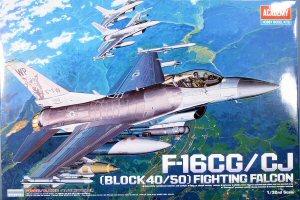
Academy 1/32 F-16CG/CJ Fighting Falcon Kit First Look
By Michael Benolkin
| Date of Review | April 2005 | Manufacturer | Academy |
|---|---|---|---|
| Subject | F-16CG/CJ Fighting Falcon | Scale | 1/32 |
| Kit Number | 12101 | Primary Media | Styrene |
| Pros | Lots of options, easy construction, great detailing | Cons | Nothing noted |
| Skill Level | Basic | MSRP (USD) | $109.95 |
First Look
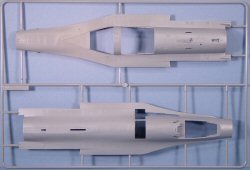 |
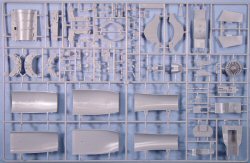 |
 |
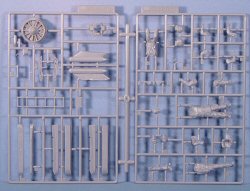 |
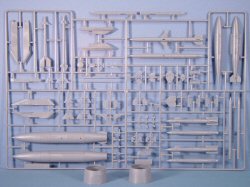 |
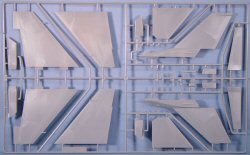 |
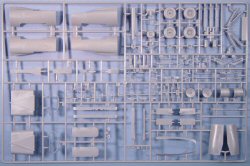 |
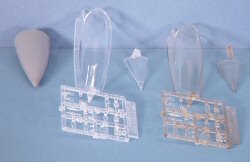 |
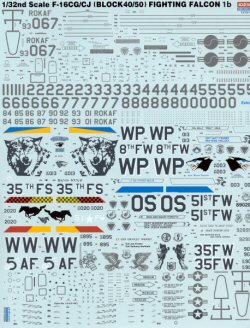 |
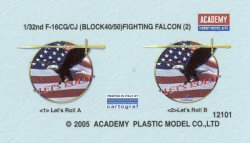 |
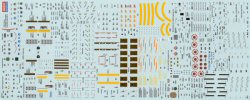 |
The F-16 started out in the lightweight fighter program that was going to provide a mix of a heavy duty fighter/interceptor (F-15) with an inexpensive, agile dogfighter. General Dynamics pitted its single-engined YF-16 against the Northrop twin-engined YF-17. Of course we know that the F-16 won out with the Air Force, but the Navy wanted two engines, so they somehow arranged for McDonnell Douglas to take Northrop's design and turn it into a carrier-capable multi-role fighter we now know as the F/A-18 Hornet.
The F-16A/B was the first generation of fighters that were adopted by the USAF and a number of NATO countries. The next generation was the F-16C/D which incorporated improvements in avionics and engine. The F-16A/C are single-seat aircraft whilst the F-16B/D are the two seat trainer versions.
The Pratt & Whitney F100 engine powered all of the F-16A/B aircraft as well as the initial F-16C/D models, but the engine was plagued with problems that resulted in aircraft losses and grounding of the entire fleet on several occasions. To reduce risk to the program, General Electric was given the nod to take their F101 engine from the B-1 and develop the derivative fighter engine, the F101DFE later redesignated as the F110. The GE engine had a few of its own teething problems, but today both engines are performing well. The GE engine required more airflow per pound of thrust which in turn required a larger intake. This larger intake (or widemouth) is one of the distinguishing features of the GE-powered F-16s.
The initial F-16C was referred to as the Block 25. The Block 30 introduced the GE engine, though many early Block 30s retained the narrowmouth intakes. Block 32 was the same aircraft with the Pratt engine. When the LANTIRN night attack system was in the development pipeline, the F-16CG/DG was developed to employ these new sensors. These are also referred to as the Block 40 for the GE-powered version and Block 42 for the Pratt. The main differences between Block 40/42 and the earlier versions (besides LANTIRN) are the relocated landing lights from the main gear to the nosewheel doors (the LANTIRN pods obstructed the lights), the holographic wide field of view heads up display (HUD), larger main gear wheels and bulged main gear doors to accommodate them, and more chaff/flare launchers.
F-16CJ/DJ is the Wild Weasel version of the aircraft described in the introduction of the Tamiya F-16CJ review. The F-16CJ Block 50 is the GE-powered airframe and the Block 52 is powered by the Pratt. The new F-16C CCIP updates the cockpits of both the F-16CG/CJ to use color displays, employ the advanced IFF system (the bird cutter blades ahead of the windscreen) and enables the F-16CJ to carry a laser designator pod on the starboard side of the inlet which required the relocation of the HTS pod to the port side of the inlet.
So why the detailed family tree in the introduction? You'll need to know what you're getting inside this kit! The model is molded in light gray styrene and features Academy's usual finely scribed detailing. The kit is presented on eight trees, plus one tree of clear parts and a duplicate tree with gold-tinted clear parts. While I didn't see any issues with ejector pin marks on my first pass through the kit, I did note that the external surface of the kit parts have a slight texture to them that some modelers may want to buff out depending on their painting styles.
If this were the first of the big Vipers to hit the street, it would be worth going into detail about the kit layout and assembly. You will want to know that holding the fuselage and wings against the Tamiya and Hasegawa kits, they are almost perfectly matched. Dry-fitting the Cutting Edge seamless F-16 intake to the Academy kit shows that it will adapt nicely and require just a bit of adapting to mate to the underside of the nose (with similar work required for the Tamiya kit as well). So far, these kits are evenly matched.
The Tamiya kit builds a Block 50 (GE-powered) F-16CJ. Period. The Academy kit will build into a Block 40 or 42 F-16CG OR a Block 50/52 F-16CJ. Intakes, engine faces, turbine faces, afterburner spray assemblies and engine nozzles for the F100 and F110 engines are provided. Excellent!
The Tamiya kit features a removable engine, detailed engine bay, removable tail, ejection seat and weapons. The Academy kit does not. For most folks, this is no big deal.
The Tamiya kit provides clear or tinted canopies. The Academy does as well, plus provides the different styles of HUD for the F-16CG/CJ.
The Tamiya kit is armed with the AIM-120B/C on stations 1/9; AIM-9L/M or AIM-120B/C on stations 2/8; AGM-88 HARM or GBU-31 JDAM on stations 3/7; 370 gallon external fuel tanks on stations 4/6; 300 centerline fuel tank or ALQ-184 ECM pod on station 5; and the HTS pod on station 5b.
The Academy kit is armed with AIM-9L/M, AIM-9X (!!!), or AIM-120B/C on stations 1/9; AIM-9L/M, AIM-9X (!!!), or AIM-120B/C on stations 2/8; AGM-88 HARM, GBU-31 JDAM, or GBU-12 Paveways on stations 3/7 (the GBU-12s have the interim TERs to carry two on each station); 370 gallon external fuel tanks on stations 4/6; 300 centerline fuel tank or ALQ-184 ECM pod on station 5; the HTS pod on station 5b or LANTIRN on stations 5a/5b. In addition, you have the ALE-50 Fiber-Optic Towed Decoy equipped pylon for station 8 which has never been done for a kit before.
For some peculiar reason, the Academy kit provides two HTS pods, both for the starboard side.
Both kits have boarding ladders, positionable radomes to reveal the radar, optional open M61 Vulcan gun bays, positionable canopies, advanced IFF, positionable speed brakes, wing trailing edge flaps, and stabiliators. For some reason, Academy molded the leading edge flaps up and locked.
If you're wanting to build a Greek or other late F-16C user that opted for the brake parachute housing at the base of the tail, you're in luck. This kit gives you that option.
In addition, ASPJ parts are included for the ECM gear adopted to some foreign F-16s including the ROKAF example that is also portrayed as an option in this kit.
While seated pilot figures are provided in both kits, the Academy kit has a standing pilot figure and a ground crewman, all of which look as nice as the figures included in their magnificent Hornets.
Markings are provided for six aircraft. The first decal sheet was slightly larger than my scanner! The aircraft portrayed in this kit are:
- F-16CG Block 40, 89-2013, 8 FW, Kunsan AB, South Korea, Sep 2004
- F-16CG Block 40, 89-2003, 35 FS/8 FW, Kunsan AB, South Korea, Aug 2004
- F-16CG Block 40, 89-2020, 51 FW, Osan AB, South Korea, Sep 2004
- F-16CJ Block 50, 92-3895, 5 AF (35 FW), Misawa AB, Japan, Feb 2005
- F-16CJ Block 50, 92-3901, 35 FW, Misawa AB, Japan, Sep 2004
- KF-16C Block 52, 93-4067, Han-guk Kong Goon, RoKAF
The RoKAF Viper is painted with the F-15 style of Dark Ghost Gray over Light Ghost Gray.
The decals include a very complete set of maintenance stencils in English and Korean, different styles of air refueling receptacle markings, and a fantastic set of weapons decals that I'd wish they'd sell separately. Lastly a pair of 'Lets Roll' markings are included for three of the aircraft marking options, the difference between the two is the USAF logo on the bottom of the right decal.
So you're wondering which kit to buy. The Tamiya kit has some interesting features with the removable tail and weapons. Handy for transporting the completed model to/from the contest. The Academy kit doesn't limit you to the Block 50 as you have the parts for the Block 40/42 and Block 50/52 in the box, plus options for RoKAF, Greek (or other parabrake housing user), CCIP (advanced IFF), and more. The most important factor to many people is the price. At $109.00 USD MSRP, the Academy kit is two thirds the price of the Tamiya kit. More bang for the buck!
So which one will I buy? I already have a couple of the Tamiya kits and I will get at least one more of the Academy kits as well. With the parts options in both kits and a little mix/match during construction, I feel some nice variants coming soon. This kit is definitely recommended!
My sincere thanks to MRC for this review sample!







